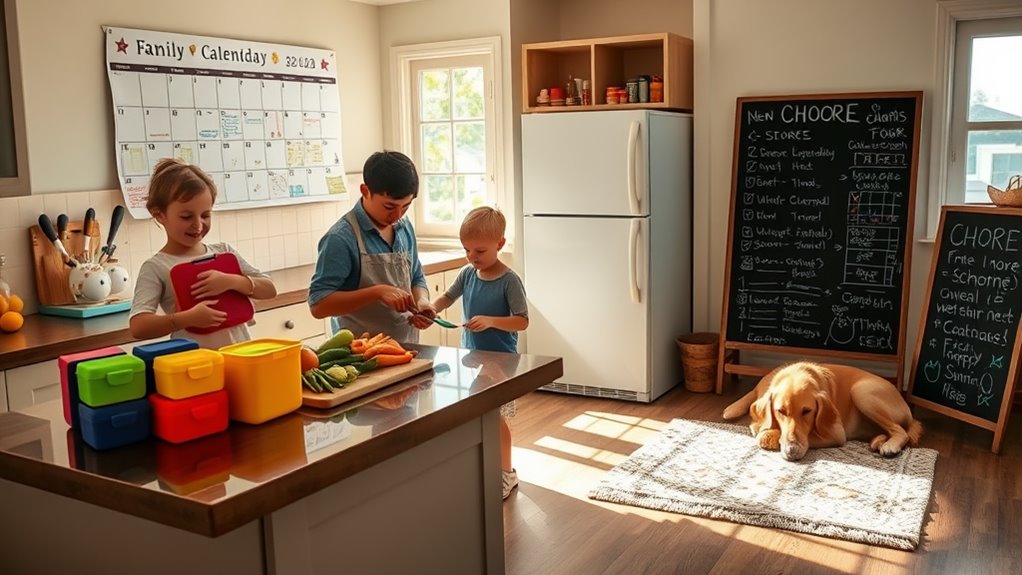The Family Routine That Keeps Everyone Happy and Organized
Establishing a family routine keeps everyone happy and organized by creating structure and predictability in daily life. Start your day with a family breakfast to connect and plan. After school, designate snack time and an organized homework zone to help kids unwind and focus. In the evenings, wind down with cozy activities like reading or gratitude sharing, promoting relaxation and strong bonds. Use a family calendar for tracking schedules and consider color-coding tasks for clarity. Flexibility is key, so regularly check in as a family to adjust routines. Discover how these routines can transform your family’s dynamic even further.
Key Takeaways
- Establish a consistent morning routine to promote connection and set a positive tone for the day ahead.
- Create designated after-school activities and snack times to help children unwind and refocus on responsibilities.
- Implement evening wind-down activities, such as reading and gratitude sharing, to enhance relaxation and family bonding.
- Utilize a family calendar to keep track of schedules and responsibilities, ensuring everyone stays organized and informed.
- Regularly assess and adapt routines together, fostering ownership and improving overall family satisfaction and engagement.
Benefits of a Family Routine
When you establish a family routine, you create a foundation for happiness and organization that benefits everyone in the household. Routines bring predictability, making daily life smoother and reducing stress. When each family member knows what to expect, it fosters a sense of security and stability.
You’ll notice improved communication as everyone learns to share responsibilities and support one another. Furthermore, routines help children develop essential life skills, like time management and self-discipline. By setting aside specific times for activities, you also encourage quality bonding experiences, strengthening family ties.
Additionally, consistent routines can lead to healthier habits, ensuring that meals, chores, and relaxation time are balanced. Ultimately, a well-structured routine paves the way for a happier, more organized home life.
Essential Morning Routines
Establishing essential morning routines can set a positive tone for the entire day.
When you create a structured start, everyone feels more prepared and energized.
Here are three key habits to implement:
-
Wake Up Early: Give yourself extra time to breathe, reflect, or enjoy a quiet moment before the chaos begins.
-
Family Breakfast Together: Share a nutritious meal where everyone can connect and share their plans for the day.
-
Plan the Day: Spend a few moments discussing everyone’s schedules. This helps everyone feel involved and reduces stress.
After-School Transition Strategies
As the school day wraps up, moving smoothly into the evening can make a world of difference for both kids and parents.
To ease this change, set a consistent routine that everyone knows. When your child comes home, have a designated snack time to refuel and unwind.
Next, create a homework zone that’s organized and free from distractions. Encourage your child to spend a few minutes discussing their day, which can help them process their experiences.
If they’ve extracurricular activities, plan ahead so they know what to expect.
Finally, involve your kids in planning dinner to make them feel engaged and responsible.
These strategies will help everyone shift gears and set a positive tone for the evening ahead.
Evening Wind-Down Activities
To create a calming atmosphere that signals the end of the day, consider incorporating evening wind-down activities into your family’s routine.
These activities help everyone relax and reflect, making it easier to shift into bedtime.
-
Cozy Reading Time: Snuggle up with your favorite books. This shared experience can ignite imaginations and foster connections.
-
Gentle Stretching or Yoga: Engage in simple stretches or yoga poses together. It promotes relaxation and helps release the day’s tension.
-
Gratitude Sharing: Gather around and share one thing you’re grateful for from the day. This practice cultivates positivity and strengthens family bonds.
Tips for Staying Organized
While juggling family life can be overwhelming, implementing a few simple organization tips can make a significant difference.
Start by creating a family calendar to keep track of everyone’s activities. Use color-coded labels to quickly identify who’s doing what.
Set aside a specific spot for important documents and daily essentials like keys and backpacks to reduce clutter.
Establish a weekly decluttering routine—spend just 10 minutes each Sunday tidying up shared spaces. Encourage everyone to pitch in; assign tasks based on age and capability.
Finally, embrace digital tools like apps for grocery lists and reminders.
Maintaining Family Routines Over Time
Maintaining family routines over time can feel challenging, especially as schedules change and kids grow.
It’s essential to stay flexible and adapt your routines to fit your family’s evolving needs. Here are three ways to keep everyone engaged and happy:
-
Involve everyone: Get input from all family members about what works for them, fostering a sense of ownership.
-
Set regular check-ins****: Schedule time to discuss what’s working and what isn’t, allowing everyone to voice their feelings.
-
Celebrate milestones: Acknowledge achievements, big or small, to boost morale and reinforce the importance of your routines.
Frequently Asked Questions
How Do I Create a Family Routine From Scratch?
Start by identifying your family’s needs and goals. List daily activities, set specific times for each, and involve everyone in the planning. Be flexible, and adjust as necessary to keep things enjoyable and efficient.
What if Family Members Resist the Routine?
If family members resist the routine, listen to their concerns and involve them in discussions. You can adjust the plan together, ensuring everyone feels heard and valued, which fosters a sense of ownership and cooperation.
Can Routines Be Flexible for Special Occasions?
Absolutely, routines can be flexible for special occasions! You can adjust schedules, allowing for spontaneity and fun. Just communicate with everyone involved, and make sure to celebrate those moments while maintaining some structure when needed.
How Do I Involve Children in Planning Routines?
You can involve your children in planning routines by asking for their input on activities, letting them choose specific tasks, and encouraging them to set goals. This way, they feel invested and motivated to participate.
What Are Signs That Our Routine Needs Adjustment?
If you notice increased stress, frequent arguments, or kids resisting activities, it’s a sign your routine needs adjustment. Pay attention to everyone’s moods and energy levels, and be willing to adapt for better harmony.




